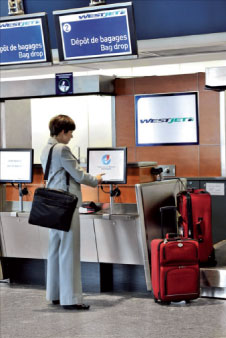New technology is an integral factor in ADM’s strategy to enhance passenger processing and improve the airport experience. The latest innovation was introduced on 6 June when 18 automated border control self-service kiosks became operational, allowing Canadian citizens returning to Canada to quickly complete the primary customs inspection themselves. The passenger simply has to follow the on-screen instructions before proceeding to a designated border services officer who can quickly verify the documents.
“This new system can process passengers five times faster than the traditional process,” said James C. Cherry, President and CEO, Aéroports de Montréal. “Results and feedback have already been excellent since the first few days of operation.”
The installation of the automated border control system follows on from the commencement of a self-service baggage drop off pilot, which the airport has initiated in partnership with Westjet. Passengers are able to use kiosks to check-in and print their baggage tags before dropping their bag at a dedicated counter. Two of the bag drop facilities are currently in place and Cherry revealed that based on the performance so far, several new positions are planned and additional airlines are expected to join the scheme. He added: “Results are very good in terms of throughput and passenger feedback. This self-service baggage drop process offers a transaction time of less than a minute per passenger.”
Despite the focus on self-service, Cherry explained that the idea at the heart of each of the initiatives is to offer more choice, rather than replace human agents. “Today’s passengers want to be more in control of their journey and want to have more choices. By being able to offer the possibility to customise their process, passengers can utilise the process that best fits their needs and provides them with the best experience. The goal of self-service is not to remove the human touch when needed or requested; it is there to offer a fast track alternative to passengers that do not require assistance,” he said.
Elsewhere in the airport process, at the security screening touchpoint, ADM has made real-time queuing times available. While this service is presently available via the airport’s website, it is also being adapted for use with the mobile website, so that passengers with a mobile device will be able to check queuing times while they’re at the airport. The mobile website, which was launched last November and recently won the ACI North America Excellence in Communication Award, also provides a link to ADM’s SMS flight information and alerts service.
Video-based tracking

At Montréal-Trudeau Airport, Westjet passengers can use kiosks to check-in and print their baggage tags before dropping their bag at a dedicated counter.
While the continued investment highlights ADM’s desire to keep pace with the latest technological trends, it also shows the importance that is placed on ensuring that the passenger is satisfied with each step of the airport process. In fact, having just completed the implementation of the new automated border control kiosks, the next project is already well underway as ADM starts work on finalising the deployment of a video-based passenger tracking solution in the international arrivals hall, which will obtain live data on passenger numbers and measure actual waiting times. “This system will provide opportunity for better pro-active operational response, facilitate planning, validate the impact of new technologies being deployed or new queuing layouts, and will soon provide the opportunity to offer arriving passengers the estimated wait time at Canadian customs,” Cherry added.
While each of these projects will undoubtedly help the airport to optimise its own operations, it will equally ensure that the passenger is presented with an array of options and services to help make their journey as seamless and enjoyable as possible.







